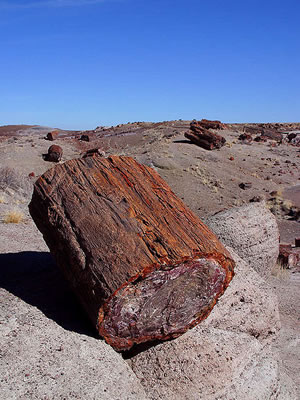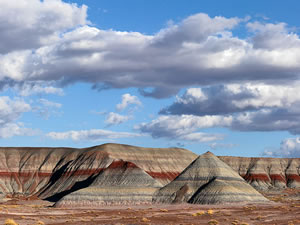The Petrified Forest in northeastern Arizona contains the largest collection of fossilized trees in the world.
The bark, sap and woody flesh of ancient trees have been turned to stone. Quartz crystals make them sparkle - yellow, orange, pink and gold.
Formation of the Petrified Forest
 Around 200 million years ago, the area that is now home to the Petrified Forest was a broad, swampy floodplain.
Around 200 million years ago, the area that is now home to the Petrified Forest was a broad, swampy floodplain.
Dinosaurs roamed among giant conifers on the slopes of hills and volcanic mountains.
Ninety per cent of the trees reached 30m (100ft) in height and had a diameter of around 2m (6.6ft). Some were twice as tall.
Eventually the trees died. Floodwaters swept them away periodically. They became trapped in gullies or in huge logjams.
The trees became covered deposits of mud and sand, as well as with ash from nearby volcanoes
They then underwent a metamorphosis.
Groundwater absorbed silica from the volcanic ash as well as other minerals from the sediments. This mineral-rich water soaked into the tissues of the tree trunks, permeating cell walls with molecules of silica.
These either turned into quartz or mixed with other minerals and crystallized into semiprecious quartz jewels, such as agate, jasper, onyx, carnelian or amethyst.
As the trees were transformed, the minerals either took on the shape of the wood cells and multiplied into precise stone copies of the trees, or they replaced the wood cells and formed huge, inexact replicas of the trees.
 As millions of years passed, new sediments covered the logs' coating of mud, ash and silt, turning it into hard layers of shale and sandstone that geologists call the Chinle Formation. By this time, the logs were buried up to a depth of 300m (1,000ft).
As millions of years passed, new sediments covered the logs' coating of mud, ash and silt, turning it into hard layers of shale and sandstone that geologists call the Chinle Formation. By this time, the logs were buried up to a depth of 300m (1,000ft).
The Petrified Forest is Exposed
Around 65 million years ago, a slow but massive upheaval of the Earth's crust caused the Rocky Mountains to rise.
This caused the petrified trees' burial ground to be pushed up at least 1.6km (1mi). The newer, less resistant sediments became exposed to the elements and were eroded away.
Eventually, the layers of shale and sandstone around the petrified logs were also removed. The ancient trees took returned to their place beneath the sun.
Dinosaur fossils were also exposed. They can be found on the desert floor.
As erosion wears away the soil, petrified trees and other fossils continues to be unearthed.